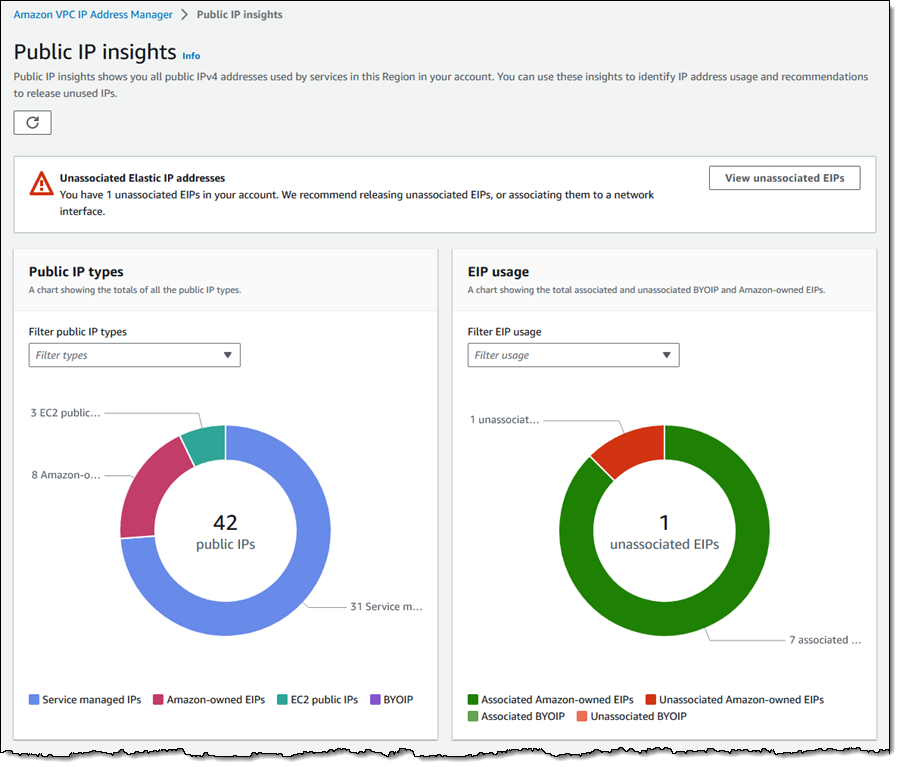AWS News Blog
New – AWS Public IPv4 Address Charge + Public IP Insights
|
|
We are introducing a new charge for public IPv4 addresses. Effective February 1, 2024 there will be a charge of $0.005 per IP per hour for all public IPv4 addresses, whether attached to a service or not (there is already a charge for public IPv4 addresses you allocate in your account but don’t attach to an EC2 instance).
Public IPv4 Charge
As you may know, IPv4 addresses are an increasingly scarce resource and the cost to acquire a single public IPv4 address has risen more than 300% over the past 5 years. This change reflects our own costs and is also intended to encourage you to be a bit more frugal with your use of public IPv4 addresses and to think about accelerating your adoption of IPv6 as a modernization and conservation measure.
This change applies to all AWS services including Amazon Elastic Compute Cloud (Amazon EC2), Amazon Relational Database Service (RDS) database instances, Amazon Elastic Kubernetes Service (Amazon EKS) nodes, and other AWS services that can have a public IPv4 address allocated and attached, in all AWS regions (commercial, AWS China, and GovCloud). Here’s a summary in tabular form:
| Public IP Address Type | Current Price/Hour (USD) | New Price/Hour (USD) (Effective February 1, 2024) |
| In-use Public IPv4 address (including Amazon provided public IPv4 and Elastic IP) assigned to resources in your VPC, Amazon Global Accelerator, and AWS Site-to-site VPN tunnel | No charge | $0.005 |
| Additional (secondary) Elastic IP Address on a running EC2 instance | $0.005 | $0.005 |
| Idle Elastic IP Address in account | $0.005 | $0.005 |
The AWS Free Tier for EC2 will include 750 hours of public IPv4 address usage per month for the first 12 months, effective February 1, 2024. You will not be charged for IP addresses that you own and bring to AWS using Amazon BYOIP.
Starting today, your AWS Cost and Usage Reports automatically include public IPv4 address usage. When this price change goes in to effect next year you will also be able to use AWS Cost Explorer to see and better understand your usage.
As I noted earlier in this post, I would like to encourage you to consider accelerating your adoption of IPv6. A new blog post shows you how to use Elastic Load Balancers and NAT Gateways for ingress and egress traffic, while avoiding the use of a public IPv4 address for each instance that you launch. Here are some resources to show you how you can use IPv6 with widely used services such as EC2, Amazon Virtual Private Cloud (Amazon VPC), Amazon Elastic Kubernetes Service (Amazon EKS), Elastic Load Balancing, and Amazon Relational Database Service (RDS):
- Dual Stack and IPv6-only Amazon VPC Reference Architectures (pdf)
- Dual-stack IPv6 architectures for AWS and hybrid networks – Part 1
- Dual-stack IPv6 architectures for AWS and hybrid networks – Part 2
- IPv6 on AWS
- AWS Services that Support IPv6
Earlier this year we enhanced EC2 Instance Connect and gave it the ability to connect to your instances using private IPv4 addresses. As a result, you no longer need to use public IPv4 addresses for administrative purposes (generally using SSH or RDP).
Public IP Insights
In order to make it easier for you to monitor, analyze, and audit your use of public IPv4 addresses, today we are launching Public IP Insights, a new feature of Amazon VPC IP Address Manager that is available to you at no cost. In addition to helping you to make efficient use of public IPv4 addresses, Public IP Insights will give you a better understanding of your security profile. You can see the breakdown of public IP types and EIP usage, with multiple filtering options:

You can also see, sort, filter, and learn more about each of the public IPv4 addresses that you are using:

Using IPv4 Addresses Efficiently
By using the new IP Insights tool and following the guidance that I shared above, you should be ready to update your application to minimize the effect of the new charge. You may also want to consider using AWS Direct Connect to set up a dedicated network connection to AWS.
Finally, be sure to read our new blog post, Identify and Optimize Public IPv4 Address Usage on AWS, for more information on how to make the best use of public IPv4 addresses.
— Jeff;
